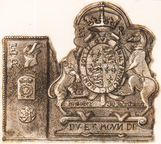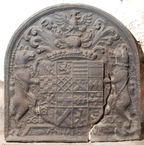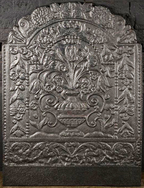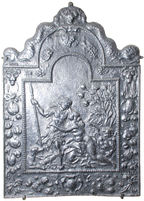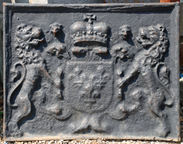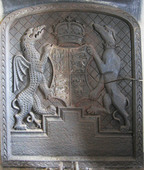-
474
Description: Fragment; arched rectangular shape with rounded corners; ovolo within fillet moulding all round; oval Tudor royal shield with garter surrounding, topped with a royal crown; dragon and greyhound supporters; initials split by crown; inscription on a fillet between legs of supporters, behind garter finial; motto on an Ionic plinth at bottom; left hand rectangular extension panel with twisted rope edging on top and side: initials in top left corner, ‘dragon’s head’ in top right corner, rose-en-soleil stamp in centre, rose stamp bottom centre.
Notes: The letters on the extension panel are the same form and size as those on the top of the armorial pattern, indicating that they were added to the armorial, perhaps to indicate a change of reign. The letter 'E' has also been noted on another fireback of the same series. The rose-en-soleil was the badge of King Edward IV and, thus, a Yorkist symbol; it is seen on other firebacks. From a house in Chailey, Sussex. Illustration from Lower (1849).
Inscription: E R / E / R / HONY SOIT QUE MAL Y PAYNCE / Made in Sussex by John Harvo / DV ET MOVN DR...
Arms: Tudor royal
- Decoration tags:
- rectangular with round arch (shape)
- complex individual (edging)
- carved stamps
- whole carved pattern
- individual letters
- armorial
- royal
- text
- animals
- plants
Manufactured: in the mid- to late-16th century in the Weald area of England.
Current location: not known.
- Attached to series:
- Pounsley series
- John Harvo series
- Rose-en-soleil series
-
498
Description: Arched plate; ovolo moulding edging; shield, supporters, coronet, helm, crest and motto of Viscount Montague; quarterly Browne, Albini, Fitzalan, Fitzalan of Clare, Warren, Maltravers, Nevill, Montagu, Monthermer, Inglethorpe, Burghe, Delapole, Bradeston, Tiptoft, Charleton and Kent (Plantagenet); supporters: two bears collared and chained; the crest: an eagle, the wings elevated and displayed.
Notes: The arms of either the 2nd (Anthony-Maria Browne, succ. 1592-1629) or 3rd viscount (Francis Browne succ. 1629-1682) - the 1st viscount was a Knight of the Garter and no garter is shown; the style of the modelling bears similarities to that on the 1618 series of firebacks and may be the work of the same pattern-maker.
Inscription: 16 / VERITATE DUCE [Be led by Truth]
Arms: Viscount Montague
- Decoration tags:
- rounded arched (shape)
- ovolo (edging)
- whole carved pattern
- armorial
- text
Manufactured: in the late-16th to early-17th century in England.
Current location: Cowdray House ruins, Midhurst, West Sussex, England.
Citation: Dawson, C., 1903, 'Sussex Iron Work and Pottery', Sussex Archaeological Collections, 46, pp. 1-54.
Citation: Gardner, J. S., 1898, 'Iron Casting in the Weald', Archaeologia, 56, 1, pp. 133-164.
- Attached to series:
- Cowdray firebacks
- Personal armorial firebacks
-
1161
Description: Arched rectangular central panel with bead-and-pellet edging (top and sides); on a ground between two plants, their flowers upstanding, a gadrooned flower vase with two, scrolled handles, tulips and other flowers issuing from the narrow neck; arched rectangular border with fillet edging; mirrored descending flower swags; along a rectangular bottom panel with fillet edging a symmetrical arrangement of swirled foliage; on top, two mirrored sea serpents; at the sides, a narrow vertical extension bordered with a fillet and with bead infill; at the base, a plain extension panel.
Notes: The presence of tulips suggest a Dutch origin for the pattern of this fireback, although the presence of several examples in England suggest that it was produced there rather than on the Continent. One of several very similar designs, varied by the forms of the vases, the style of the flowers and by their dimensions. Copies of this fireback, without the extension at the bottom, were advertised in Kings Worthy Foundry's (Winchester) catalogue in the mid-20th century.
Copies of this fireback are known.
- Decoration tags:
- 'Dutch' (shape)
- fillet (edging)
- whole carved pattern
- extension panels
- pictorial
- plants
- objects
Manufactured: in the late-17th century in England.
Current location: not known.
- Attached to series:
- Flower Vase 'Dutch' types
- British 'Dutch' style firebacks
-
557
Description: Arched rectangular central panel with bead edging; pictorial scene of Venus, naked and kneeling, and Adonis, standing, holding a spear in his left hand, with Cupid to the left, and a hound and a quiver of arrows below to the right; arched rectangular border with fillet edging; at top of arch, grape bunches; at each side, a festoon of fruit suspended on a ribbon from a lion's head; at the bottom, an oval cartouche between flowers; on top, an urn from which descends a dolphin on each side of the arch.
Notes: The scene is based on the painting (c.1635) of Venus and Adonis by Peter Paul Rubens; the same central panel is known with several different borders. Mitford collection, Petworth House.
Copies of this fireback are known.
- Decoration tags:
- 'Dutch' (shape)
- fillet (edging)
- whole carved pattern
- pictorial
- mythological
- humans
Manufactured: in the mid- to late-17th century in the Siegerland area of Germany.
Current location: Petworth House, Petworth, West Sussex, England.
Museum number: NT/PET/M/49 (part of the National Trust museum group)
- Attached to series:
- 'Dutch' Miscellaneous Firebacks
- 'Dutch' Venus and Adonis firebacks
-
833
Description: Rectangular; cavetto-moulded edging; armorial of France modern in front of a cartouche; above, an English royal crown between two small lion masks; two lion rampant supporters.
Notes: Believed to be associated with the marriage, in 1625, of Charles I with Princess Henrietta Maria of France, the juxtaposition of the arms of France with an English crown is seen on several firebacks, normally with a distinctive ornate edging; on this fireback is the unusual addition of two lion supporters, which are heraldically incorrect.
Arms: France modern
- Decoration tags:
- rectangular (shape)
- cavetto (edging)
- whole carved pattern
- armorial
Manufactured: in the early- to mid-17th century possibly in the Weald area of England.
Current location: Mark Ripley Forge & Fireplaces, Northbridge Street, Robertsbridge, East Sussex, England.
- Attached to series:
- Miscellaneous royal firebacks
- Anglo-French armorial firebacks
-
758
Description: Flattened arched rectangular shape; cavetto moulded edge all round; armorial; arms of Browne family of Brenchley, Kent: Gules, a griffin passant or, a chief of the second; Crest: a vulture proper, wings endorsed, displuming a mallard’s wings.
Notes: John Browne, gunfounder, was granted arms in 1626. His principal furnace was in Brenchley parish, Kent. The royal gunfounder 1615-51, he petitioned the Crown for a monopoly of casting firebacks in 1633.
Copies of this fireback are known.
Arms: Browne of Brenchley (John Browne)
- Decoration tags:
- rectangular with round arch (shape)
- cavetto (edging)
- whole carved pattern
- armorial
Manufactured: in the early- to mid-17th century possibly at Brenchley and Horsmonden Furnace in the Weald area of England.
Current location: Victoria & Albert Museum, Cromwell Road, Kensington & Chelsea, Greater London, England.
Museum number: 493.1901 (part of the Victoria & Albert Museum museum group)
- Attached to series:
- Personal armorial firebacks
-
1246
Description: Low-arched shape within broad fillet edging marked with a repeated leaf pattern ascending toward the top; on an incised criss-cross field a Tudor royal shield, quarterly France Modern and England, supported by a stylised, scaly dragon and greyhound and surmounted by a crown, all resting on a two-stepped compartment with cavetto- and astragal-moulded edging at the top.
Notes: Pastiche 'Tudor' design by George Shaw of Saddleworth, Lancashire, c.1850, possibly intended to be passed off as genuine Tudor. Another casting in this form is in Cheetham's Library, Manchester. A variant exists without the leaf pattern on the edging and the 'scales' on the dragon. Firebacks of the same armorial design within a different, arched rectangular, edging are also known.
Copies of this fireback are known.
Arms: Tudor royal
- Decoration tags:
- rounded arched (shape)
- custom with repeated leaf pattern (edging)
- whole carved pattern
- heraldic
- armorial
- royal
Manufactured: in the mid-19th century possibly in the Lancashire area of England.
Current location: Warkworth Castle, Warkworth, Northumberland, England.
(part of the English Heritage museum group)
- Attached to series:
- Tudor royal armorial firebacks
- George Shaw series
